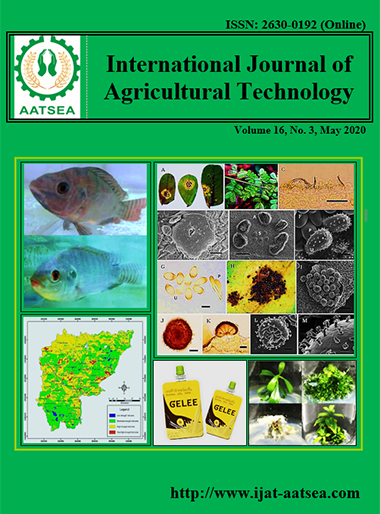Growth and yield of sweet corn cultivated in soil using third reused nutrient solution
Main Article Content
Abstract
Nutrient solution from growing lettuce using Nutrient Film Technique (NFT) was drained from the substrate culture to grow Chinese kale in Dynamic Root Floating Technque (DRFT) before the third usage for growing melon. The third re-used nutrient solution (UNS) was drained from the melon growing substrate, diluted with tap water, and adjusted the concentration to 2.0 mS/cm2, pH 5.8 before irrigation on the sweet corn field. Control plants were grown under general management (manual watering and fertilizing with 15-15-15 fertilizer). Results indicated that growth parameters including shoot height, SPAD value and fresh weight per plant using the third UNS were not significantly different from the control. Yield parameters including number of ears, average weight per ear and average weight per plant using the third UNS also showed no significant differences from the control. Water consumption of sweet corn under treatment of the third UNS and the control were 35.55 and 108.23 L/plant, respectively resulted to reduced water consumption of up to 68.07% and no fertilizer was used in the UNS treatment. Thus, the UNS method reduced both water and fertilizer consumption, while minerals in the nutrient solution were completely utilized, leading to cost reduction and environmentally friendly waste production.
Article Details

This work is licensed under a Creative Commons Attribution-NonCommercial-NoDerivatives 4.0 International License.
References
Al-Karaki, G. N. (2011). Utilization of treated sewage wastewater for green forage production in a hydroponic system Emirates Journal of Food and Agriculture, 23:80-94.
Bertoldi, F. C., Sant’Anna, E. andBarcelos-Oliveira, J. L. (2009) Chlorella vulgaris cultivated in hydroponic wastewater. Proc. IS on Soilless culture and Hydroponics. Eds. A Rodriguez-Delfin and PF Martinez.ActaHort 843. ISHS 2009, pp. 203-210.
Boonnoi, N., Nuntagij, I. and Koohakan, P. (2017). Growth and Yield of Chinese Kale Grown in Dynamic Root Floating Technique (DRFT) by Reused Nutrient Solution. International Journal of Agricultural Technology, 13:1469-1477.
Boonnoi, N., Nuntagij, I. and Koohakan, P. (2018). The management of used-nutrient solution from Chinese kale grown in DRFT for growing melon in substrate culture. The National Horticultural Conference 17th.Chiangmai Grand View & Convention Center, Chiangmai, Thailand, November,19-21, 2018.
Choi, B., Lee, S.S. and Ok, Y. S. (2011b). Effects of Waste Nutrient Solution on Growth of Chinese Cabbage (Brassica campestris L.) in Korea. Korean Journal of Environmental Agriculture, 30:125-131.
Choi, B., Lim, J.E., Shin, Y. K., Yang, J. E., Lee, S. S. and Ok, Y. S. (2011a). Effect of Waste Nutrient Solution and Reclaimed Wastewater on Chinese Cabbage Growth and Soil Properties. Korean Journal of Soil Science and Fertilizer, 44:394-399.
Correa, R. M, Pinto, S. I. D. C, Reis, E. S. and Carvalho, V. A. M. D. (2012). Hydroponic production of fruit tree seedlings in Brazil, hydroponics—a standard methodology for plant biological researches, Dr. Toshiki Asao (Ed.), ISBN: 978-953-51-0386-8, InTech.
Gent, M. P. N. and Short, M. R. (2012). Effect on yield and quality of a simple system to recycle nutrient solution to greenhouse tomato. Horticultural Science, 47:1641- 1645.
Grasselly, D., Merlin, G., Sedilot, C., Vanel, F., Dufour, G. andRosso, L. (2005). Denitrification of soilless tomato crops run-off water by horizontal subsurface constructed wetlands. ActaHorticulturae, 691:329-332.
Haddad, M. and Mizyed, N. (2011). Evaluation of various hydroponic techniques as decentralised wastewater treatment and reuse systems.International Journal for Environmental Studies, 68:461-476.
Hong, K. C., Choi, B., Lim, K. J., Won, J. H., Hur, S. O., Ha, S. K., Kim, N. W., Yang, J. E. and Ok, Y. S. (2009). Effects of reclaimed waste water and waste nutrientsolution irrigation on seedling growth ofChinese cabbage. Korean Journal of Environmental Agriculture, 28:171-178
Kumar, R. R. and Cho, J. Y. (2014). Reuse of hydroponic waste solution. Environmental Science and Pollution Research, 21:9569-9577.
Park, J. B. K., Craggs, R. J. and Sukias, J. P. S. (2008). Treatment of hydroponic wastewater by denitrification filters using plant pruning as the organic carbon source. Bioresource Technology, 99:2711-2716.
Park, C. J., Yang, J. E., Kim, K. H., Yoo, K. Y. and Ok, Y. S. (2005). Recycling of hydroponic waste solution for red pepper (Capsicum annum L.) growth. Korean Journal of Environmental Agriculture, 24:24-28.
Postel, S. (2001). Growing more food with less water. Scientific American, 284:46-51.
Prystay, W. and Lo, K. V. (2001). Treatment of greenhouse wastewater using constructed wetlands. Journal of Environmental Science and Health - Part B Pesticides, Food Contaminants, and Agricultural Wastes, 36:341-353.
Savvas, D. and Gizas, G. (2002). Response of hydroponically grown gerbera to nutrient solution recycling and different nutrient cation ratios.ScientiaHorticulturae, 96:267- 280.
Singandhupe, R. B., Rao, G. G. S. N., Patil, P. S. and Brahmanand, P. S. (2003). Fertigation studies and irrigation scheduling in drip irrigation system in tomato crop (Lycopersiconesculentum L.). European Journal Agronomy, 19:327-340.
Wallace, J. S. (2000) Increasing agricultural water use efficiency to meet future food production. Agriculture, Ecosystems and Environment, 82:105-119.
Zhang, C. H., Kang, H. M. and Kim, I. S. (2006). Effect of using waste nutrient solution fertigation on the musk melon and cucumber growth. Journal Biology Environment Control, 15:400-405.


